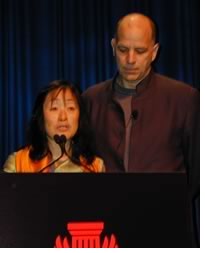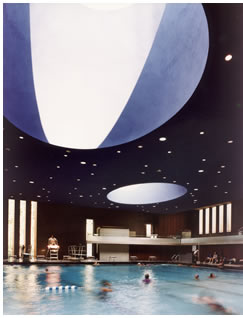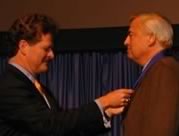

Tsien, Williams Offer
Poetry Through Beautiful “Handprints on the Earth”
Lawler receives Kemper Award; Malecha, Topaz
Medallion at opening session
 “Welcome
to the poetry and proof of architecture,” said AIA Executive Vice
President/CEO Norman L. Koonce, FAIA, in San Diego as he opened the 135th
national convention of the AIA May 8. Koonce marveled at the changes that
have touched the profession since the first AIA convention in New York
City in 1867 and how they are manifested at the convention through diverse
means, including the presence of women and minorities and the 150,000
square feet of 717 products and services on the exposition floor. He told
the session audience of more than 3,000 architects that we should celebrate
the way “our practices have changed in ways our founders could never
have imagined.”
“Welcome
to the poetry and proof of architecture,” said AIA Executive Vice
President/CEO Norman L. Koonce, FAIA, in San Diego as he opened the 135th
national convention of the AIA May 8. Koonce marveled at the changes that
have touched the profession since the first AIA convention in New York
City in 1867 and how they are manifested at the convention through diverse
means, including the presence of women and minorities and the 150,000
square feet of 717 products and services on the exposition floor. He told
the session audience of more than 3,000 architects that we should celebrate
the way “our practices have changed in ways our founders could never
have imagined.”
Koonce introduced the AIA’s 79th president, Thompson E. Penney, FAIA, architect of the convention’s theme, “Design Matters: Poetry + Proof,” the ineffable blend of artistic magic and scientific method that makes up the soul of architecture and uplifts the human spirit. Penney said that not a day of the last two years went by without some communication and collaboration about turning his vision into “one of the world’s premier design events.” He thanked the “hundreds of people who breathed life into the convention, foremost, Paul D. Boney, FAIA, chair of this year’s convention, who in turn acknowledged Randal Peterson, AIA, and Thomas Anglewicz, AIA, the AIA San Diego cochairs of the event.
Tsien, Williams reflect on what’s
important
Keynote speakers Tod Williams, FAIA, and Billie Tsien, AIA, principals
of New York City’s renowned and well-respected Tod Williams &
Billie Tsien, Architects, opened their discussion of the poetry part of
architecture with images of prehistoric handprints, indicating that humans
have used their hands for 30,000 years as the way of leaving their mark
on the earth. “Architecture is our way of leaving handprints on
the wall,” Williams said.
 Since
the September 11 attacks, Tsien said, the two have been thinking hard
about what matters in architecture. As the only architect on the board
to select the finalists for the rebuilding of Ground Zero, she learned
that “people believe in architecture as a way of sharing dreams.”
People rejected the first round of schemes, she said, because they realized
that the first attempts “represented money only and were not expressive
of the future.” The second round of designs all were excellent and
she “felt proud to be an architect,” she said. The process
represents that people can be effective in the design process, Williams
added, and that buildings must be designed and constructed with integrity.
Great architecture doesn’t say “I was here” but rather
proclaims collectively “we were here,” he said.
Since
the September 11 attacks, Tsien said, the two have been thinking hard
about what matters in architecture. As the only architect on the board
to select the finalists for the rebuilding of Ground Zero, she learned
that “people believe in architecture as a way of sharing dreams.”
People rejected the first round of schemes, she said, because they realized
that the first attempts “represented money only and were not expressive
of the future.” The second round of designs all were excellent and
she “felt proud to be an architect,” she said. The process
represents that people can be effective in the design process, Williams
added, and that buildings must be designed and constructed with integrity.
Great architecture doesn’t say “I was here” but rather
proclaims collectively “we were here,” he said.
Examples of excellence
Tsien and Williams presented five examples of their work that illustrate
their dedication to these themes:
• A house outside of Phoenix composed of two earth-hugging bars of sandblasted local concrete block that frame a bridged-over wash. The bars offer two large planes that protect the interior of the house from the harsh sun. A cut in the bridge allows the family to enjoy the wash in its vastly changing forms. The architects chose the house as an example of response to place by using simple materials in a thoughtful way.
 •
The Natatorium at the Cranbrook Academy, Bloomfield Hills, Mich., continues
the devotion to excellence in the craft of architecture at the academy,
which benefited from the presence of Eliel Saarinen for decades in the
early part of the 20th century. Tsien describes the campus as “incredibly
romantic” in its connection to both the arts and nature. The natatorium,
which has 25-foot-tall glass doors that open to the outside as well as
tremendous skylights that open to the sky, further relates to its site
through wood details that harken its pine-forest surround and allow the
large pool area to function “as a quiet space,” according
to Tsien.
•
The Natatorium at the Cranbrook Academy, Bloomfield Hills, Mich., continues
the devotion to excellence in the craft of architecture at the academy,
which benefited from the presence of Eliel Saarinen for decades in the
early part of the 20th century. Tsien describes the campus as “incredibly
romantic” in its connection to both the arts and nature. The natatorium,
which has 25-foot-tall glass doors that open to the outside as well as
tremendous skylights that open to the sky, further relates to its site
through wood details that harken its pine-forest surround and allow the
large pool area to function “as a quiet space,” according
to Tsien. ![]()
• The Neurosciences Research Institute in La Jolla, Calif., a project composed of two building masses and an interior court, the “parapeteia,” that allows people of diverse scientific backgrounds to meet by chance and, in the architects’ words, “build a sense of community.” Its folded-plate chamber music hall is known for its excellent acoustics as well as its beauty. Some 40 percent of the concrete and fossil stone building sits underground, furthering the connection between nature and architecture. The project, which won a 1997 AIA Honor Award, is a living example of the architects’ belief that the interior of the building is as important as the exterior. They designed the tapestries and furniture that enliven the common spaces where the scientists can enjoy food and casual conversation.
 •
New York City’s Museum of American Folk Art, a 2003 Honor Award
winner, was conceived as a “house of art,” according to Williams.
The compact building, 40 feet wide by 100 feet deep, is surrounded by
the Museum of Modern Art and becomes “the jewel in the bellybutton
of MOMA,” says Tsien. It buries two of its five floors underground
and uses a grand scale for internal circulation. Bronze panels, 5/8-inch
thick, are each different, and, because they reflect the sky, each panel
is “different all the time,” Williams said. The architects
were inspired by Frank Lloyd Wright’s Guggenheim Museum and have
achieved, through the Folk Art Museum, a “Guggenheim in a box,”
Tsien joked.
•
New York City’s Museum of American Folk Art, a 2003 Honor Award
winner, was conceived as a “house of art,” according to Williams.
The compact building, 40 feet wide by 100 feet deep, is surrounded by
the Museum of Modern Art and becomes “the jewel in the bellybutton
of MOMA,” says Tsien. It buries two of its five floors underground
and uses a grand scale for internal circulation. Bronze panels, 5/8-inch
thick, are each different, and, because they reflect the sky, each panel
is “different all the time,” Williams said. The architects
were inspired by Frank Lloyd Wright’s Guggenheim Museum and have
achieved, through the Folk Art Museum, a “Guggenheim in a box,”
Tsien joked. ![]()
• The last project offered by Tsien and Williams was the work performed
by the firm for the Robin Hood Foundation, a philanthropic organization
that helps underprivileged schools in New York City to rebuild their libraries.
Architects donate their time to the schools, and Tsien and Williams will
have completed four such projects by year’s end. ![]()
The architects concluded their talk with a homage to those who make art out of craft; who use their hands. Architects need to learn from craftspeople, they said, to stay connected to artisanship as they move through this digital age.
Copyright 2003 The American Institute of Architects.
All rights reserved. Home Page ![]()
![]()
 |
||
| Also at the theme session, Penney presented the 2003 Edward C. Kemper Award to C. James Lawler Jr., FAIA, founder and principal of C.J. Lawler Associates in West Hartford, Conn. Named in honor of the AIA’s first executive director, the award recognizes individuals who contribute significantly to the profession of architecture through service to the AIA.
Lawler has served at all levels with each of his local and regional AIA boards and committees, culminating with his election to the national AIA Board of Directors and the AIA presidency in December 1990. A major supporter of a stronger bond between education and practice, Lawler also has been involved with the National Architectural Accrediting Board (NAAB) since 1993, making more than 20 accreditation visits and chairing 10 of them. Penney and ACSA President Brad Grant, AIA, also had the privilege of presenting the 2003 AIA/ACSA Topaz Medallion for Excellence in Architectural Education to architect and educator, Marvin J. Malecha, FAIA, dean of the College of Design at N.C. State University, Raleigh.
The Topaz Medallion honors an individual who has made outstanding contributions to architecture education for at least 10 years, and whose teaching has influenced a broad range of students and shaped the minds of those who will shape our environment. For 12 years prior to his tenure at N.C. State, Malecha served as dean of the College of Environmental Design at California State Polytechnic University, Pomona. Malecha has served as president of the ACSA and the California Council of Architectural Education, as well as vice chair of the AIA/ACSA Council on Architectural Research.
|
||


 McGraw-Hill
Construction President Norbert Young Jr., FAIA introduced keynote
speakers Billie Tsien, AIA, and Tod Williams, FAIA. McGraw-Hill
is the sponsor of all three convention theme sessions. Young also
received heartfelt congratulations from President Penney and the
audience, as McGraw-Hill ’s Architectural Record received
the 2003 National Magazine for general excellence in the 100,000–250,000
circulation category from the American Society of Magazine Editors
on May 7.
McGraw-Hill
Construction President Norbert Young Jr., FAIA introduced keynote
speakers Billie Tsien, AIA, and Tod Williams, FAIA. McGraw-Hill
is the sponsor of all three convention theme sessions. Young also
received heartfelt congratulations from President Penney and the
audience, as McGraw-Hill ’s Architectural Record received
the 2003 National Magazine for general excellence in the 100,000–250,000
circulation category from the American Society of Magazine Editors
on May 7.